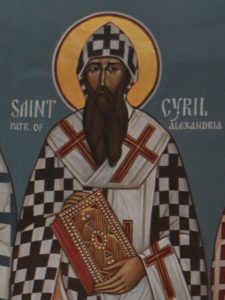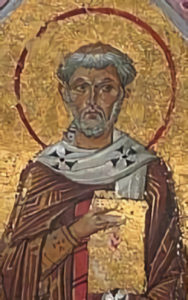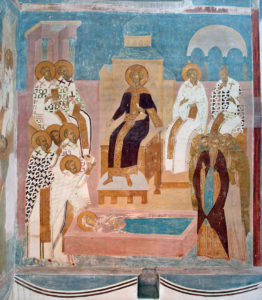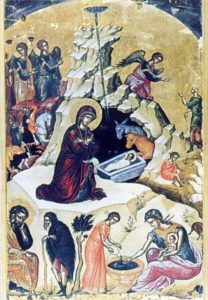A Greek Start to the New Year
by Fr. William Rock, FSSP
The Roman Liturgy has never been afraid to borrow from other Apostolic Liturgical traditions in order to enrich her own. Such a borrowing occurs on the Octave Day of Christmas, January 1st, where the Benedictus Antiphon at Lauds is extracted from a hymn of the Greek Church which is sung on December 26th, a day the Greeks consecrate to the celebration of the Blessed Virgin Mary. The Latin of this Antiphon is as follows:
Mirábile mystérium declarátur hódie: innovántur natúræ, Deus homo factus est: id quod fuit permánsit, et quod non erat assúmpsit; non commixtiónem passus, neque divisiónem.
Which can be translated as:
An admirable mystery is this day revealed: the two Natures are united in a new way, God is made Man: He remained what He was, and He assumed what He was not, suffering neither confusion nor division.1
The subject matter of this Antiphon is one of the central mysteries of the Christian Faith and a focus of the Christmas season: the Incarnation. Unfortunately, various heresies have arisen over the course of the history of Christianity regarding this truth. Succinctly do the various parts of the Antiphon declare the Catholic and Apostolic Faith on the matter. Each will be treated in turn.

“The two Natures are united in a new way” – Prior to the Incarnation, the only union of the Divine and Human Natures, the two natures referred to by this portion of Antiphon, was when God brought those who believed in Him into a State of Sanctifying Grace, making them “partakers of the Divine Nature” (2 Pet 1:4).2 But, even though a man thus sanctified participated in the Divine Life and was elevated supernaturally, he still remained a human person, he still only possessed human nature. An elevated human nature to be sure, one united to and participating in the Divine Nature, but still only a human nature. In the case of Our Lord, the unity between His Divine and Human Natures was something completely new and unique to Him. He was not a Divine Person participating in human nature, nor was He a human person participating in the Divine Nature – as is possibly the case for all human persons. Rather, in the case of the Our Lord, the Divine and Human Natures were united personally. He is One Person in Two Natures. He is both God and Man.

“God is made man” – The Arian heresy claimed that “the Word (Logos) does not exist from all eternity. He is not generated from the Father, but is a creature of the Father, created by Him from nothing before all other creatures.”3 The Arians would hold, then, that the Word which was made man was only a creature and not God. Contrary to this, the First Ecumenical Council of Nicaea (A.D. 325) taught that the One Who became Incarnate was “God from God, light from light, true God from true God…consubstantial with the Father”4 and the Creed Quicumque Vult (also known as the Athanasian Creed) declares the Son, the Word, to be “uncreated,” “eternal,” and that the “Son is God,”5 just as the Father is. This portion of the Antiphon excludes the Arian position that a creature, even the greatest of creatures, was made man by declaring that “God,” and nothing other than God, “is made man.” “God” meaning here, of course, the Person of the Son and “man” meaning, as explained in the just mentioned Creed, “perfect man, consisting of a rational soul and a human body.”6

“He remained what He was” – It is tempting to think that when the Son became Man, He underwent some sort of change, with something either being added to or taken away from His Divine Nature which allowed for its union with His Human Nature. But the Council of Nicaea anathemized in its Creed the position that the Son is “changeable or mutable,”7 for the Divine Nature is incapable of change. In the same vein, the Fathers of the Ecumenical Council of Ephesus (A.D. 431) proclaimed, “We do not say that the nature of the Word was changed” in the Incarnation (The Epistle of Cyril to Nestorius).8 And so, in the Incarnation, the Son remained what He was. His Divine Nature did not undergo any change whatsoever nor did it somehow suffer loss or a lessening in the Incarnation.

“He assumed what He was not” – While the Son, co-equal and co-eternal with the Father, was, is, and always will be God, in the Incarnation, He became man. He, being God and remaining God, became what He was not: Man. As the Creed Quicumque Vult explains, the Incarnation occurred “not by the conversion of the Divinity into a human body [which would be a change of the Divinity], but by the assumption of the humanity in the Godhead.”9 That the Word assumed a Human Nature is the language of the Ecumenical Council of Chalcedon (A.D. 451) and The Tome of St. Leo (A.D. 499).10

“Suffering neither confusion” – The heresy of Monophysitism claimed that Christ is One Person and one nature. Some Monotheists “assumed a confusion or mixture of the Two Natures into one new third nature.”11 Contrary to this position, the Council of Chalcedon defined: “that one and the same Christ, the Son, the Lord, the Only-begotten is to be recognized in two natures without confusion…The distinction between the natures was never abolished by their union but rather the character proper to each of the two natures was preserved as they came together.”12 The One Person of the Son is preserved as well as the integrity of both the Divine and the Human Nature – for Our Lord is truly God and truly man, not some strange third thing.
“Nor division” – While the Monophysites combined the two Natures of Christ into one, those who followed the Nestorian heresy divide the Two Natures into two persons who are united morally. Nestorianism was condemned by the early Ecumenical Councils of Ephesus and Chalcedon. The Council of Chalcedon “declared that the two natures of Christ are joined ‘in one Person…’”13 To partially fill in the ellipse from the preceding paragraph, the same Council taught “that one and the same Christ, the Son, the Lord, the Only-begotten is to be recognized in two natures without confusion…without division or separation.”

And thus, in only a few phrases, the Roman Benedictus Antiphon for the Feast of the Circumcision summarizes the main teachings of the Catholic Church regarding the Incarnation. By the prayers of her liturgy, the Church protects and declares the true faith.
Pondering all of what has just been said in our hearts, we clearly see that the opening of the Antiphon rings true, “an admirable mystery is this day revealed!”
William Rock, FSSP was ordained in the fall of 2019 and is currently assigned to Regina Caeli Parish in Houston, TX.
1. Prosper, Guéranger. The Liturgical Year – Volume II – Christmas, Book I. Fitzwilliam: Loreto Publications, 2000, p. 388. The antiphon can be variously translated. The Divinum Officium Project provides the following translation: “This day is set forth a wonderful mystery, a new thing hath been created in the earth: God is made man. That which He was, He remaineth; and that which He was not, He taketh; suffering therein neither confusion nor division.” For the purpose of this article, however, the translation from The Liturgical Year was used.
2. See Ott, Ludwig, Fundamentals of Catholic Dogma. Baronius Press, 2018, p. 276.
3. Ibid., p. 57.
4. Denzinger, Henry, The Sources of Catholic Dogma [1954]. Fitzwilliam: Loreto Publications, 2010, §54.
5. Ibid., §§39-40.
6. Ibid.
7. Ibid., §54.
8. Ibid., §111a.
9. Ibid., §§39-40.
10. Ibid., §143.
11. Ott, p. 159.
12. Ibid.
13. Ibid., p. 157.
January 18, 2022








